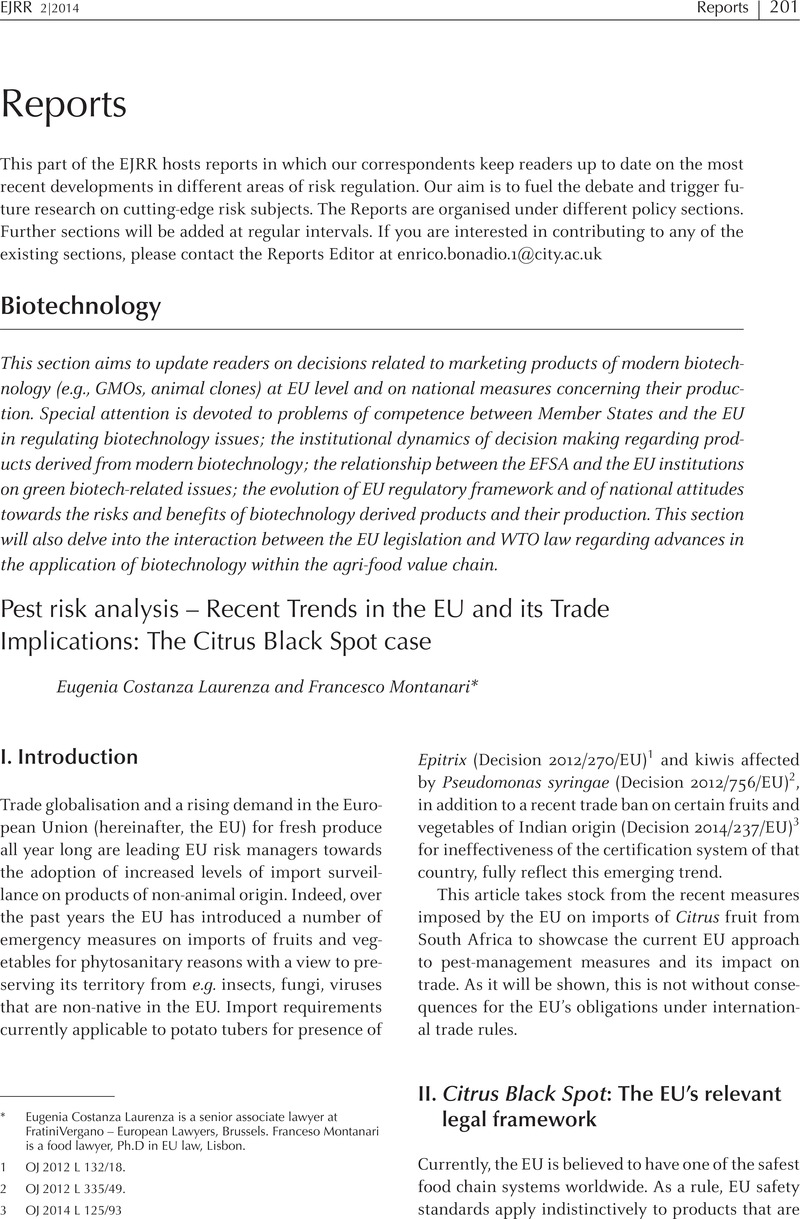Published online by Cambridge University Press: 20 January 2017

1 OJ 2012 L 132/18.
2 OJ 2012 L 335/49.
3 OJ 2014 L 125/93
4 OJ 2013 L 334/44.
5 OJ 2002 L 169/1.
6 Annex IV, Section I, Part A pt. 16.4.
7 OJ 2006 L 187/35.
8 As per joint reading of Articles. 13, 13a and Part B of Annex V of Directive 2000/29/EC.
9 Article 16(1).
10 EFSA Journal 2014;12(2):3557.
11 EFSA supporting publication 2014:EN-555.
12 Ibidem, e.g. p. 12, pt. 3 (MGAP/DGSA/URY), and, similarly, p. 15, pt. 5 (SENAVE, PRY).
13 Ibidem, pt. 17, p 22 and pt.18, p. 25 (CAG/ZAF).
14 Wolfrum, R., Stoll, P.T. and Seibert-Fohr, A. (eds), WTO – Technical Barriers and SPS Measures, Max Planck Institute for Comparative Public Law and International Law, Martinus Nijhoff Publishers, p. 399.Google Scholar
15 Annex A to the SPS Agreement defines risks assessment as: “[t]he evaluation of the likelihood of entry, establishment or spread of a pest or disease within the territory of an importing Member according to the sanitary or phytosanitary measures which might be applied, and of the associated potential biological and economic consequences; or the evaluation of the potential for adverse effects on human or animal health arising from the presence of additives, contaminants, toxins or disease-causing organisms in food, beverages or feedstuffs”. According to Article 5.2 of the SPS Agreement, relevant risk factors that need to be taken into account in the assessment of the risks include, inter alia, available scientific evidence, relevant processes and production methods, inspection, sampling and testing methods, prevalence of specific diseases or pests, relevant ecological and environmental conditions, and quarantine or other treatment. On the other hand, the economic factors that WTO Members need to take into consideration when assessing the risk include: the potential damage in terms of loss of production or sales in the event of the entry, establishment or spread of a pest or disease; the costs of control or eradication in the territory of the importing Member; and the relative costeffectiveness of alternative approaches to limiting risks.
16 Appellate Body report, Australia – Measures Affecting the Importation of Apples from New Zealand (Australia – Apples), WT/DS367/AB/R, para. 210; Appellate Body report, Japan – Measures Affecting Agricultural Products, WT/DS76/AB/R, para. 84.
17 Panel Report, Japan – Measures Affecting the Importation of Apples, Recourse to Article 21.5 of the DSU by the United States, WT/DS245/RW, para. 8.45. See also Panel Report United States – Certain Measures Affecting Imports of Poultry from China, WT/DS392/R, para. 7.200.
18 South Africa restated its views at a meeting of the WTO Committee on SPS Measures held in June 2013, by referring to a previous statement delivered at the meeting of the same Committee in July 1997 with respect to import requirements notified by the EU in June 1997. See Summary of the Meeting of 27 – 28 June 2013, Note by the Secretariat, G/SPS/R/71, p. 7.
19 Panels charged with such tasks would have to review the underlying scientific basis for the EU's SPS measure. A review of consistency with Article 5.1 of the SPS Agreement would require a panel to “determine whether that risk assessment is supported by coherent reasoning and respectable scientific evidence and is, in this sense, objectively justifiable”(see Australia – Apples, Appellate Body Report, para. 215). The Appellate Body clarified that panels would carry out such review by (i) scrutinising the underlying scientific basis to review whether the scientific basis constitutes “legitimate science according to the standards of the relevant scientific community” and (ii) assess the reasoning of the risk assessor based upon such science to evaluate whether the conclusions find sufficient support in the scientific evidence relied upon.
20 Panel report, European Communities – Measures Concerning Meat and Meat Products (Hormones), WT/DS26/R/USA, para. 8.166; Panel report, European Communities – Measures Concerning Meat and Meat Products (Hormones), WT/DS48/R/CAN, para. 8.169.
21 Appellate Body report, Australia – Measures Affecting Importation of Salmon, WT/DS18/AB/R, para. 194. The Appellate Body developed this interpretation on the basis of footnote 3 to the SPS Agreement, which states that: “[f]or purposes of paragraph 6 of Article 5, a measure is not more trade-restrictive than required unless there is another measure, reasonably available taking into account technical and economic feasibility, that achieves the appropriate level of sanitary or phytosanitary protection and is significantly less restrictive to trade”. See also Australia – Apples, paras. 336–337.
22 Commission Implementing Decision 2011/778/EU of 28 November 2011 authorising certain Member States to provide for temporary derogations from certain provisions of Council Directive 2000/29/EC in respect of seed potatoes originating in certain provinces of Canada (notified under document C(2011) 8633), OJ 2011 L 317/37.